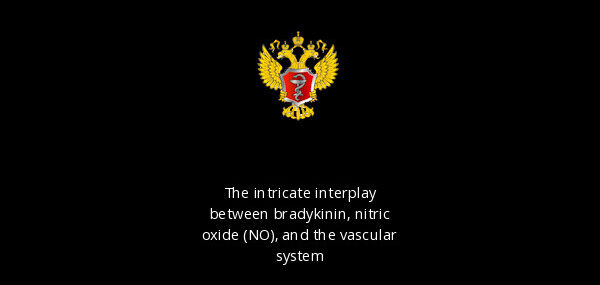The intricate interplay between bradykinin, nitric oxide (NO), and the vascular system
Bradykinin is a peptide that plays a role in various physiological processes, including vasodilation. The intricate interplay between bradykinin, nitric oxide (NO), and the vascular system involves several cycles and mechanisms.
1. Bradykinin Stimulation of NO Production:
- Bradykinin stimulates the release of endothelial nitric oxide synthase (eNOS), an enzyme responsible for the production of nitric oxide.
- eNOS catalyzes the conversion of L-arginine into NO, which is a potent vasodilator.
2. NO-Mediated Vasodilation:
- NO, once produced, diffuses into vascular smooth muscle cells.
- Inside these cells, NO activates guanylate cyclase, leading to the formation of cyclic guanosine monophosphate (cGMP).
- cGMP acts as a second messenger, promoting smooth muscle relaxation.
- This relaxation results in vasodilation of blood vessels, reducing vascular resistance and improving blood flow.
3. Initial Vasoconstriction Followed by Late Vasodilation:
- It’s essential to note that while NO primarily induces vasodilation, in some situations, an initial vasoconstriction may occur.
- This initial vasoconstriction is due to other factors like the interaction of NO with reactive oxygen species or its impact on other vasoactive substances.
- The initial vasoconstriction is usually followed by a more pronounced and sustained vasodilation.
4. Smoking and Headaches:
- Smoking is associated with vasoconstriction due to various mechanisms, including the direct effects of nicotine on blood vessels.
- Nicotine can cause constriction of cerebral blood vessels, leading to reduced blood flow and oxygen supply to the brain.
- This vasoconstriction can contribute to headaches and may exacerbate other cardiovascular issues associated with smoking.
5. ACE Inhibitors and Vasodilation:
- ACE (Angiotensin-Converting Enzyme) inhibitors, like captopril, interfere with the renin-angiotensin-aldosterone system.
- By inhibiting ACE, these drugs decrease the production of angiotensin II, a vasoconstrictor.
- The reduction in angiotensin II levels contributes to vasodilation and decreased blood pressure.
6. Involved Cycles:
- Bradykinin stimulates NO production, leading to vasodilation.
- NO has dual effects, including initial vasoconstriction and subsequent, more pronounced vasodilation.
- Smoking, through various mechanisms, contributes to vasoconstriction, impacting cerebral blood flow.
- ACE inhibitors interfere with the renin-angiotensin system, promoting vasodilation.
Understanding these cycles helps to appreciate the complex regulation of vascular tone by bradykinin, NO, and other vasoactive substances. It’s crucial to consider individual factors, such as smoking, and the effects of medications like ACE inhibitors in the context of overall cardiovascular health
Verified by: Dr.Diab (March 29, 2024)
Citation: Dr.Diab. (March 29, 2024). The intricate interplay between bradykinin, nitric oxide (NO), and the vascular system. Medcoi Journal of Medicine, 3(2). urn:medcoi:article32158.












There are no comments yet
Or use one of these social networks